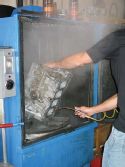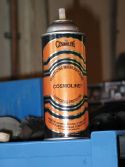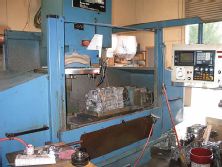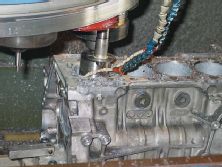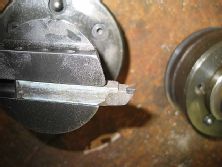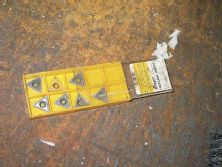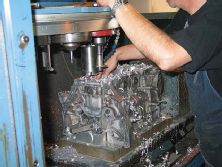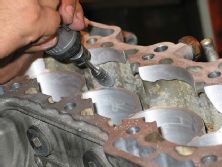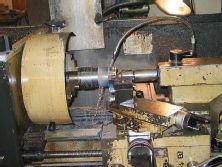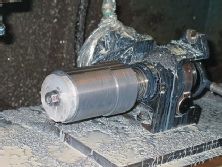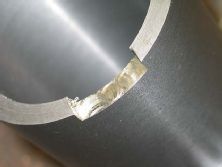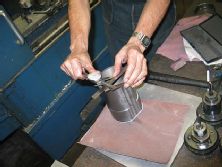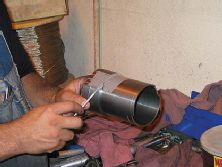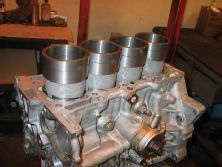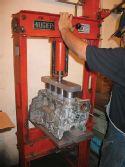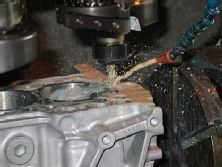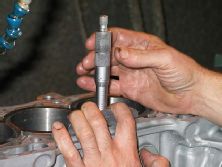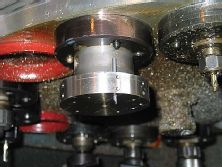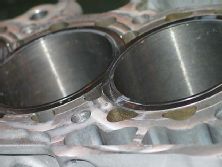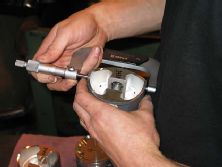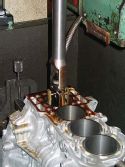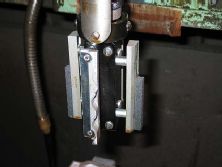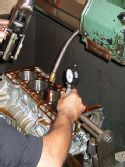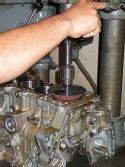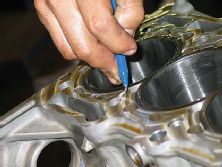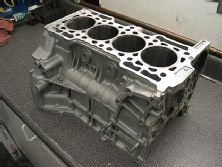When last we spoke all those months ago (Sept. '03) about our H22-to-EG Civic hatchback swap we told you everything was installed, assembled and ready to go. it was--for a little while anyway. But the poor former-Prelude powerplant had a run of misfortune.
The piston rings weren't seated correctly at Holeshot and were subsequently destroyed through normal use--bungle numero uno. Both the sleeves and the Type-S slugs survived relatively unscathed, with only superficial damage to the sleeves. Thinking the guys could fix the damage with a light hone was bungle numbero dos.
Holeshot, for reasons we'd rather not bring up here, went out of business, so we took our beleaguered project to another shop that we leave unnamed. There it sat forgotten, mostly because it got lost in the shuffle of a significant staff change here at Honda Tuning around the same time (probably bungle number three). Months passed before we realized we had a project at the shop waiting for us, so we picked it up and got two solid weeks of driving in before the engine started losing compression.
After cursing our rotten luck for ever resuming this idiotic venture, we realized we needed to make a decision about the car. In order for our story to be complete we had to get the Civic tuned and dyno'd--these were stated goals from the outset that were nearly impossible now with a motor losing power. The H needed major work. We figured if we had to do the work, we might as well take it to the next level: forced induction.
Before we launch into that story a quick recap covering the features of the H22 is in order. The DOHC VTEC engine is found in several Prelude models and the 1994 to '97 JDM Accord SiR. The engine was seldom preferred in its native habitat because of the weight and higher price tag typically associated with these platforms.
It does offer a larger bore and stroke than your average B-series engine, however, which improves the H's torque curve--topping out at 156 lb-ft at 5250 rpm--and its desirability. By comparison, peak torque made by a B18C1, the beloved GS-R plant, is only 128 lb-ft at a higher 6200 revolutions.
Later-model H-series engines, like our H22A from a '99-to-'01 USDM 'Lude, boast a closed-deck configuration, which increases the motor's appeal to some. In fact in terms of power and compatibility the H22A is considered one of the more coveted engines, making 200 hp at the crank from the factory. It does so with a 90.7mm stroke, 87mm bore, and compression ratio of 10.0:1--which we changed when we opted for the higher domed Japanese Type-S slugs the first time around, upping compression a full point.
In the first installment (Oct./Nov. '02) we noted how thin the stock sleeves were but didn't really get into why they were so thin. The liners are referred to as fiber-reinforced metal (FRM) cylinder sleeves in the Helm's manual, which coincidentally are also used in the 3.2-liter NSX.
Making FRM sleeves goes something like this: First a fiber-based material in the shape of the cylinder sleeve is inserted into the die of the cylinder block. Liquid aluminum is then poured into the die and fuses with the fiber sleeves. Once the block is ready for it, the cylinder walls are machined to the desired bore dimension, leaving only 0.5mm of thickness to the fiber sleeves that cover the cylinder walls.
With the reinforcement the sleeves generate lower friction than traditional iron liners, which translates to improved revolutions, power and reduced wear. In addition the thinner fiber sleeves fortify the block, allowing the distance between adjacent bores to be reduced while maintaining strength and rigidity.
There are drawbacks, however. It can be argued that because they are so thin the sleeves were not designed for too much boost pressure, which limits the potential of the stock engine and poses a challenge for us.
Overboring for more displacement is also out of the question since the sleeves are so lean. Even if you machine-off enough material to avoid breaking through to a water jacket, you still have to deal with the softer untreated metal under the fiber layer. For these reasons it is recommended that H22 sleeves never be bored or honed, always replaced.
With new parameters in mind we began to rethink the parts list we had. The high-compression Type-S pistons were first to go; since a turbo is in the works those will be replaced with something less severe--dished Wiseco slugs to be precise--for a slightly lower compression ratio. We've also tapped SCAT Enterprise for some of its burly bottom-end parts, namely one of its forged crankshafts and a set of its connecting rods.
The largest contributor thus far is Golden Eagle Manufacturing in San Dimas, Calif. Not only did the company agree to prep the block for us, GE's Vince Tiaga also offered to assemble the bottom end. The crew at Golden Eagle will be pressing in tougher, thicker, ductile iron sleeves that will take the bore to 89mm and raise displacement to 2260cc, or what would be considered 2.3 liters by industry standards.
We've droned on enough. Herewith is part one (or is that part four?) of our renewed H22 swap. Enjoy.

